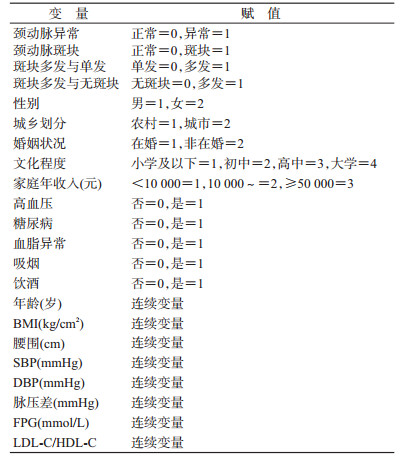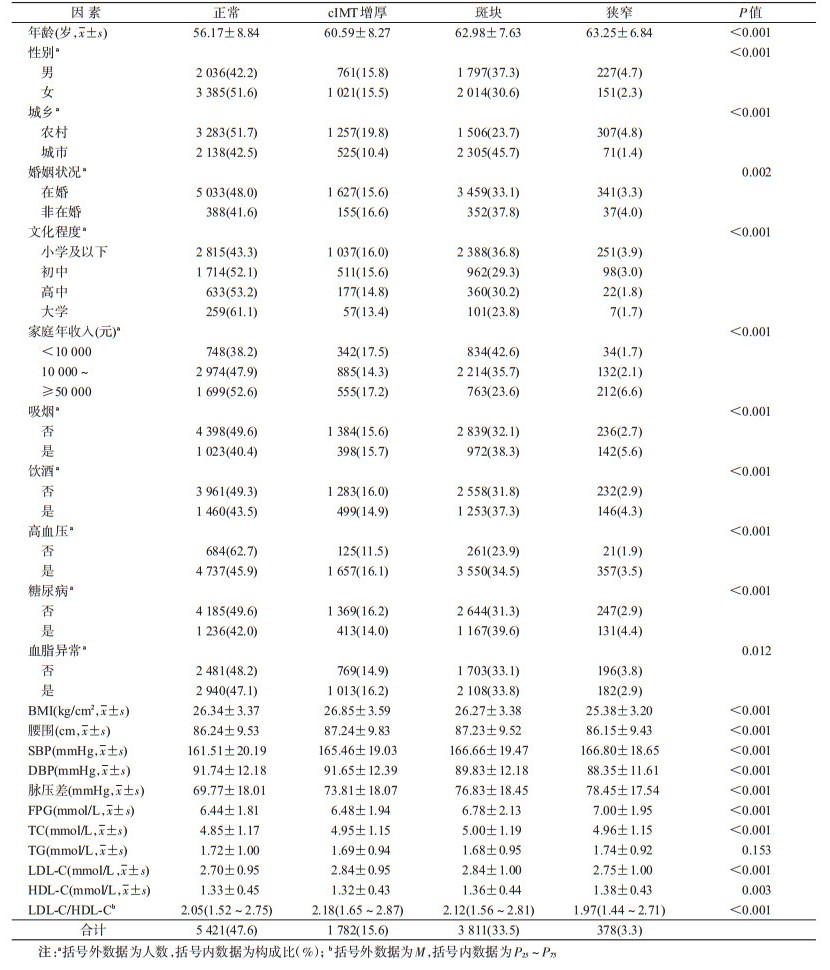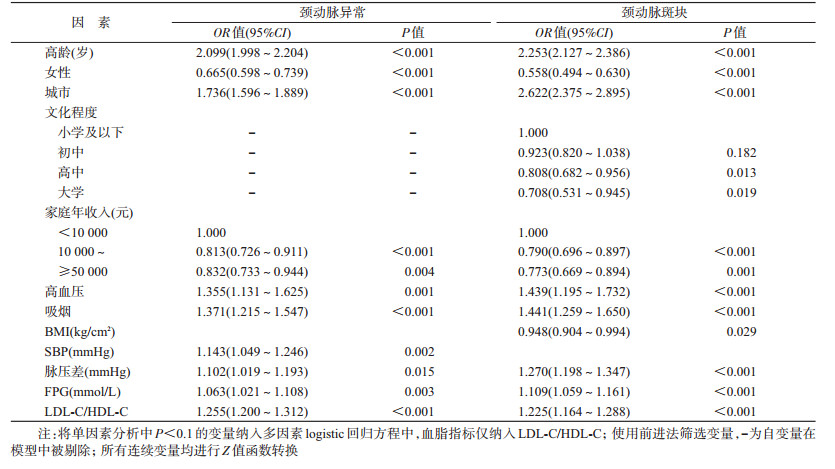| [1] |
陈伟伟, 高润霖, 刘力生, 等. 《中国心血管病报告2017》概要[J]. 中国循环杂志, 2018, 33(1): 1-8. Chen WW, Gao RL, Liu LS, et al. China cardiovascular disease report 2017[J]. Chin Circ J, 2018, 33(1): 1-8. |
|
| [2] |
Stary HC, Chandler AB, Dinsmore RE, et al. A definition of advanced types of atherosclerotic lesions and a histological classification of atherosclerosis. A report from the committee on vascular lesions of the council on arteriosclerosis, American heart association[J]. Circulation, 1995, 92(5): 1355-1374. DOI:10.1161/01.CIR.92.5.1355 |
|
| [3] |
Bis JC, Kavousi M, Franceschini N, et al. Meta-analysis of genome-wide association studies from the CHARGE consortium identifies common variants associated with carotid intima media thickness and plaque[J]. Nat Genet, 2011, 43(10): 940-947. DOI:10.1038/ng.920 |
|
| [4] |
Zhang YQ, Bai LL, Shi M, et al. Features and risk factors of carotid atherosclerosis in a population with high stroke incidence in China[J]. Oncotarget, 2017, 8(34): 57477-57488. DOI:10.18632/oncotarget.15415 |
|
| [5] |
刘卫东, 王石雷, 冯晶军, 等. 山东省聊城地区卒中高危人群的筛查及颈动脉斑块分析[J]. 中华神经外科杂志, 2018, 34(10): 1056-1058. Liu WD, Wang SL, Feng JJ, et al. Screening of high-risk stroke patients and analysis of carotid plaque in Liaocheng area, Shandong province[J]. Chin J Neurosurg, 2018, 34(10): 1056-1058. DOI:10.3760/cma.j.issn.1001-2346.2018.10.020 |
|
| [6] |
World Health Organization. Prevention of cardiovascular disease:pocket guidelines for assessment and management of cardiovascular risk[R]. Geneva:WHO, 2007:12-22.
|
|
| [7] |
国际生命科学学会中国办事处中国肥胖问题工作组联合数据汇总分析协作组. 中国成人体质指数分类的推荐意见简介[J]. 中华预防医学杂志, 2001(5): 62-63. Joint Data Analysis Collaboration Group of WGOC. Introduction to the recommendation of Chinese adult body mass index classification[J]. Chin J Prev Med, 2001(5): 62-63. DOI:10.3760/j:issn:0253-9624.2001.05.019 |
|
| [8] |
中国高血压防治指南修订委员会. 中国高血压防治指南2010[J]. 中华心血管病杂志, 2011, 39(7): 579-616. Writing Group of 2010 Chinese Guidelines for the Management of Hypertension. 2010 Chinese guidelines for the management of hypertension[J]. Chin J Cardiol, 2011, 39(7): 579-616. DOI:10.3760/cma.j.issn.0253-3758.2011.07.002 |
|
| [9] |
WHO. Definition and diagnosis of diabetes mellitus and intermediate hyperglycaemia:report of a WHO/IDF consultation[M]. Geneva: WHO Document Production Services, 2006: 1-3.
|
|
| [10] |
中国成人血脂异常防治指南修订联合委员会. 中国成人血脂异常防治指南(2016年修订版)[J]. 中国循环杂志, 2016, 31(10): 937-950. Joint Committee for the Revision of the Guidelines for Prevention and Treatment of Dyslipidemia. Guidelines for the prevention and treatment of dyslipidemia in Chinese adults (revised 2016)[J]. Chin Circ J, 2016, 31(10): 937-950. DOI:10.3969/j.issn.1000-3614.2016.10.001 |
|
| [11] |
Howard G, Sharrett AR, Heiss G, et al. Carotid artery intimal-medial thickness distribution in general populations as evaluated by B-mode ultrasound. ARIC Investigators[J]. Stroke, 1993, 24(9): 1297-1304. DOI:10.1161/01.STR.24.9.1297 |
|
| [12] |
Touboul PJ, Hennerici MG, Meairs S, et al. Mannheim carotid intima-media thickness and plaque consensus (2004-2006-2011). An update on behalf of the advisory board of the 3 rd, 4 th and 5 th watching the risk symposia, at the 13 th, 15 th and 20 th European Stroke Conferences, Mannheim, Germany, 2004, Brussels, Belgium, 2006, and Hamburg, Germany, 2011[J]. Cerebrovasc Dis, 2012, 34(4): 290-296. DOI:10.1159/000343145 |
|
| [13] | |
|
| [14] |
华扬, 陶昀璐, 李梅, 等. 多中心超声筛查中国卒中高危人群颈动脉粥样硬化性病变结果的初步分析[J]. 中国脑血管病杂志, 2014, 11(12): 617-623. Hua Y, Tao YL, Li M, et al. Multicenter ultrasound screening for the results of carotid atherosclerotic lesions in a Chinese population with high-risk of stroke:a preliminary analysis[J]. Chin J Cerebrovasc Dis, 2014, 11(12): 617-623. DOI:10.3969/j.issn.1672-5921.2014.12.001 |
|
| [15] |
Wang CF, Lv GP, Zang DW. Risk factors of carotid plaque and carotid common artery intima-media thickening in a high-stroke-risk population[J]. Brain Behav, 2017, 7(11): e00847. DOI:10.1002/brb3.847 |
|
| [16] |
Finn AV, Kolodgie FD, Virmani R. Correlation between carotid intimal/medial thickness and atherosclerosis:a point of view from pathology[J]. Arterioscler Thromb Vasc Biol, 2010, 30(2): 177-181. DOI:10.1161/ATVBAHA.108.173609 |
|
| [17] |
Enomoto M, Adachi H, Hirai Y, et al. LDL-C/HDL-C Ratio Predicts Carotid Intima-Media Thickness Progression Better Than HDL-C or LDL-C Alone[J]. J Lipids, 2011, 2011: 549137. DOI:10.1155/2011/549137 |
|
| [18] |
Tamada M, Makita S, Abiko A, et al. Low-density lipoprotein cholesterol to high-density lipoprotein cholesterol ratio as a useful marker for early-stage carotid atherosclerosis[J]. Metabolism, 2010, 59(5): 653-657. DOI:10.1016/j.metabol.2009.09.009 |
|
| [19] |
Natarajan S, Glick H, Criqui M, et al. Cholesterol measures to identify and treat individuals at risk for coronary heart disease[J]. Am J Prev Med, 2003, 25(1): 50-57. DOI:10.1016/S0749-3797(03)00092-8 |
|
| [20] |
Mathiesen EB, Johnsen SH. Ultrasonographic measurements of subclinical carotid atherosclerosis in prediction of ischemic stroke[J]. Acta Neurol Scand Suppl, 2009, 120(s189): 68-72. DOI:10.1111/j.1600-0404.2009.01210.x |
|
| [21] |
Mi T, Sun SW, Zhang GQ, et al. Relationship between dyslipidemia and carotid plaques in a high-stroke-risk population in Shandong province, China[J]. Brain Behav, 2016, 6(6): e00473. DOI:10.1002/brb3.473 |
|
| [22] |
Bian LD, Xia LL, Wang YX, et al. Risk factors of subclinical atherosclerosis and plaque burden in high risk individuals:results from a community-based study[J]. Front Physiol, 2018, 9: 739. DOI:10.3389/fphys.2018.00739 |
|
| [23] |
Spence JD, Barnett PA, Bulman DE, et al. An approach to ascertain probands with a non-traditional risk factor for carotid atherosclerosis[J]. Atherosclerosis, 1999, 144(2): 429-434. DOI:10.1016/S0021-9150(99)00003-9 |
|
| [24] |
Lorenz MW, Polak JF, Kavousi M, et al. Carotid intima-media thickness progression to predict cardiovascular events in the general population (the PROG-IMT collaborative project):a Meta-analysis of individual participant data[J]. Lancet, 2012, 379(9831): 2053-2062. DOI:10.1016/S0140-6736(12)60441-3 |
|
| [25] |
Spence JD, Hackam DG. Treating arteries instead of risk factors:a paradigm change in management of atherosclerosis[J]. Stroke, 2010, 41(6): 1193-1199. DOI:10.1161/STROKEAHA.110.577973 |
|
| [26] | |
|
| [27] |
Lorenz MW, Markus HS, Bots ML, et al. Prediction of clinical cardiovascular events with carotid intima-media thickness:a systematic review and Meta-analysis[J]. Circulation, 2007, 115(4): 459-467. DOI:10.1161/CIRCULATIONAHA.106.628875 |
|
| [28] |
Plichart M, Celermajer DS, Zureik M, et al. Carotid intima-media thickness in plaque-free site, carotid plaques and coronary heart disease risk prediction in older adults. The three-city study[J]. Atherosclerosis, 2011, 219(2): 917-924. DOI:10.1016/j.atherosclerosis.2011.09.024 |
|
| [29] |
郭璐, 宫帅, 刘跃建, 等. 老年慢性阻塞性肺疾病患者动脉粥样硬化伴狭窄的高危因素分析[J]. 中国呼吸与危重监护杂志, 2016, 15(3): 236-240. Guo L, Gong S, Liu YJ, et al. Analysis of risk factors for carotid atherosclerotic stenosis in senior chronic obstructive pulmonary disease patients[J]. Chin J Respir Crit Care Med, 2016, 15(3): 236-240. |
|
| [30] |
Park HW, Kim KH, Song IG, et al. Body mass index, carotid plaque, and clinical outcomes in patients with coronary artery disease[J]. Coron Artery Dis, 2017, 28(4): 278-286. DOI:10.1097/MCA.0000000000000467 |
|
| [31] |
Galal W, van Domburg RT, Feringa HHH, et al. Relation of body mass index to outcome in patients with known or suspected coronary artery disease[J]. Am J Cardiol, 2007, 99(11): 1485-1490. DOI:10.1016/j.amjcard.2007.01.018 |
|
| [32] |
Angerås O, Albertsson P, Karason K, et al. Evidence for obesity paradox in patients with acute coronary syndromes:a report from the Swedish Coronary Angiography and Angioplasty Registry[J]. Eur Heart J, 2013, 34(5): 345-353. DOI:10.1093/eurheartj/ehs217 |
|
| [33] |
Kalantar-Zadeh K, Kopple JD. Obesity paradox in patients on maintenance dialysis[J]. Contrib Nephrol, 2006, 151: 57-69. DOI:10.1159/000095319 |
|
| [34] |
Andersen KK, Olsen TS. The obesity paradox in stroke:lower mortality and lower risk of readmission for recurrent stroke in obese stroke patients[J]. Int J Stroke, 2015, 10(1): 99-104. DOI:10.1111/ijs.12016 |
|
| [35] |
Gao ZQ, Khoury PR, McCoy CE, et al. Adiposity has no direct effect on carotid intima-media thickness in adolescents and young adults:use of structural equation modeling to elucidate indirect & direct pathways[J]. Atherosclerosis, 2016, 246: 29-35. DOI:10.1016/j.atherosclerosis.2015.11.033 |
|
 2019, Vol. 40
2019, Vol. 40







